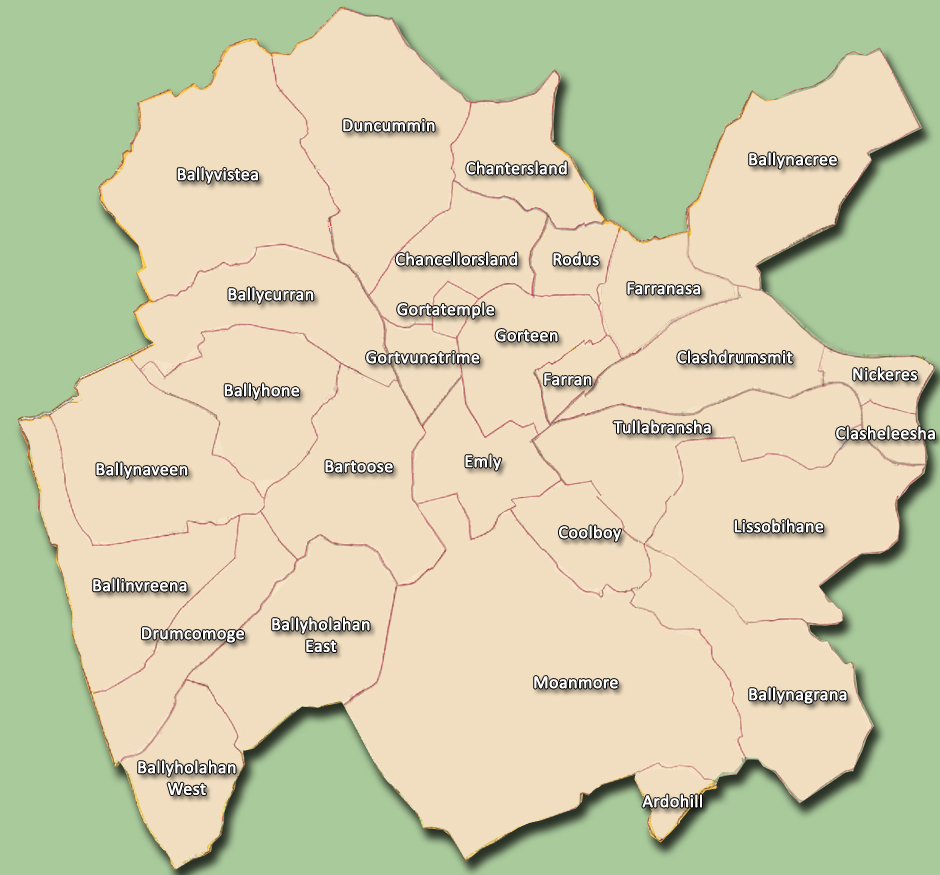
Click to enlarge
THE PARISH OF EMLY
EMLY, a parish, and the seat of a diocese, in the barony of CLANWILLIAM, county of TIPPERARY, and province of MUNSTER, 7 miles (S. W.) from Tipperary, and 15 (W.) from Cashel, on the confines of the county of Limerick; containing 3838 inhabitants, of which number, 701 are in the village. This place, noticed under the name of "Imlagh" by Ptolemy, as one of the three principal towns of Ireland, is of very remote antiquity, and was formerly an important city and the seat of a diocese. A monastery of canons regular was founded here by St. Ailbe, or Alibeus, who became its first abbot, and dying in 527, was interred in the abbey. His successors obtained many privileges for the inhabitants. The abbey and town were frequently pillaged and burnt. King John, in the l7th of his reign, granted the privilege of holding markets and fairs in the town, which, since the union of the see of Emly with that of Cashel in 1568, has gradually declined, and is now comparatively an insignificant village, containing only 115 houses. It has a constabulary police station, and fairs are held on May 21st and Sept. 22nd.
Among the successors of St. Ailbe in the SEE of EMLY, previously to the landing of the English, and who were styled indifferently abbots or bishops, were several who exercised sovereign power at Cashel, as Kings of Munster. Olchobhair Mac Cionoatha, who in 847 succeeded to the prelacy, and to the throne of Munster, aided by Lorcan, son of the King of Leinster, killed 1200 of the Danes who had plundered the monastery during the preceding year; and 1700 were slain in a subsequent battle, in which Olchobhair was killed. In 1123, during the prelacy of Moelmorda, the abbey was plundered and the mitre of St. Ailbe, which had been preserved for many ages, was burnt. Bishop Christian, who succeeded to the prelacy in 1236, was a great benefactor to the cathedral church, in which Bishop Henley, who died in 1542, erected a college of secular priests.
The last bishop of this see, prior to its union with that of Cashel, to which the archbishoprick had been previously transferred, was Reymund de Burgh, after whose death, in 1562, it remained vacant till 1568, when it was united by act of parliament to the archbishoprick of Cashel, during the prelacy of Archbishop Mac Caghwell. The diocese is one of the eleven that constitute the archdiocese, or ecclesiastical province, of Cashel: it comprises an estimated superficies of 138,050 statute acres, of which 86,150 are in the county of Limerick, and 51,900 in that of Tipperary.
The chapter consists of a dean, precentor, chancellor, archdeacon, treasurer, and the four prebendaries of Dollardstown Killenellick, Doon, and Lattin. It comprehends 17 benefices, of which nine are unions of two or more parishes, and eight are single parishes; of these, four are in the patronage of the Crown, and 13 in that of the Archbishop of Cashel. The total number of parishes is 44, of which 39 are rectories and vicarages, three perpetual curacies, and two without provision for the cure of souls; there are eleven churches and four other places in which divine service is performed, and nine glebe-houses. In the R. C. divisions the diocese is united with the archdiocese of Cashel, and contains 31 chapels.L.
The living is a vicarage, in the diocese of Emly, and in the patronage of the Archbishop of Cashel; the rectory is appropriate to the economy fund of the cathedral of Emly. The tithes amount to £450, of which £300 is payable as rectorial tithes, and the remainder to the vicar. The glebe-house is a neat building, and the glebe Comprises 10 acres. The cathedral, which serves also as the parish church, is a handsome structure of hewn stone, in the later English style, with a lofty spire, erected in 1827, at an expense of £2521. 11. 9., defrayed from a surplus of the economy fund, which had been for several years accumulating for that purpose.
The R. C. parish is co-extensive with that of the Established Church, and contains a chapel. There are two private schools, in which are about 80 children. In the churchyard is a large cross of rough stone, also a well, called St. Ailbe's well, which are held in veneration by the peasantry, who assemble here on the 12th of September, the anniversary of that saint's death. A very ancient canoe, resembling those of the South Sea islanders, was dug up some time since near the village; and very rich armlets of gold and brass swords have also been found in the adjacent bogs.
A Topographical Dictionary of Ireland, Samuel Lewis (1837)